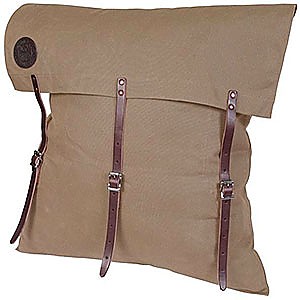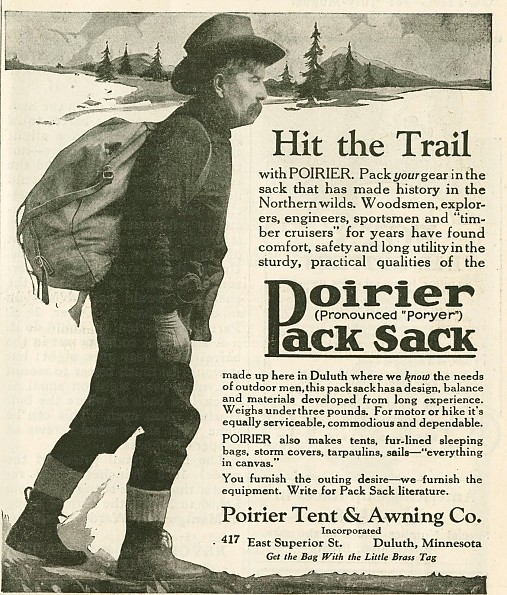Duluth #3 Original Duluth Pack

For canoe travel, packs and other gear need to easily stow in the canoe. If there are portages, containers that are easily carried are also a requirement. These two needs are well blended into the classic Original Duluth Pack. These simple packs have proven themselves over more than 100 years.
Pros
- Extremely durable
- Comfortable to carry
- Large volume
- Keeps contents dry
Cons
- Expensive
- Not lightweight
Background:
At a summer party a number of years ago, I had just returned from another trip into Canada’s Far North. As I waxed poetic on the beauty and mentioned my mode of travel, a friend commented that in his youth as a Boy Scout, he had paddled in the Boundary Waters of Minnesota and had nothing but disdain for his experience and the Duluth Pack he was forced to carry. He complained of the bugs and the tumpline on his forehead. “On your forehead” I questioned?
Over the years, I have encountered a number of people who have been turned off the outdoors in their youth by negative experiences. Sometimes it just wasn’t the right match. Often it is poor equipment or not knowing the right way to use it.
Packs or knapsacks have been around since at least the early 17th century. But it was a French Canadian in Duluth, Minnesota, in the late 19th century who actually patented the first pack sack.
Patent Drawing of Poirier's pack.
Interest in outdoor recreation was just in its infancy in 1882 and Camille Poirier saw a need for a comfortable pack that guides and clients alike could carry their kit in.
The Poirier Pack Sack soon became a hit among canoeists and anyone who spent time in the woods.
One of Camille Poirier's early advertisements.
In 1911, Camille Poirier sold his company to Duluth Tent and Awning, a newly formed company which made the packs initially under the name Monarch. Other companies over the years have made their own versions of Poirier’s pack. Although the parent company of Duluth Tent and Awning still exists as a name, the outdoor equipment company is simply known as Duluth Pack and they still make the classic canoe pack.
Initial Impression:
These are not modern high tech packs with dozens of features. The classic envelope style that Poirier designed is still being made, though without the sternum strap which is available as an extra. In fact, there are many extras that can be bought or added to the packs, making each pack truly a custom piece. Olive drab is the standard color, though other colors can be ordered specially.
As well, besides the sternum strap, packs can be ordered with padded shoulder straps, extra pockets, leather lashings, waist belt and/or D rings. Although the most popular is the #3, there is also a slightly smaller #2 and the behemoth called a #4, which is a #3 but enlarged as a box style pack. Other variations include heavier duty canvas which outfitters often order, or a less expensive construction which changes the leather shoulder straps for canvas ones. After the resurgence of interest in waxed cotton a decade ago, Duluth Pack also added a waxed finish as an option.
Since the #3 is the most popular, I’ll focus my description on that classic size and shape. Made of 15 oz canvas, with leather straps, it is not light weighing about 3.5 pounds. Size is 26 inches high and 28 inches wide. Volume is a generous 5330 cubic inches or just under 90 cubic liters.
Three 3/4 inch straps close the top flap over the interior using roller buckles. Two 2 1/4 inch wide leather shoulder straps allow a comfortable carry. A canvas tumpline completes the outside. All the leather fittings are attached with hand hammered copper rivets and heavy thread. Open the top flap and there is a small open topped pocket just inside that can carry maps, head lamps, or other small items. The rest of the interior is one large container for everything from sleeping bags, pads, tents, etc.
And to top it all off, every Duluth Pack is made in Duluth, Minnesota and comes with a lifetime warranty against defects.
One addition that Camille Poirier didn’t imagine is a large polyethylene liner that keeps the contents dry.
An advantage of the style of heavy canvas outer shell and the waterproof liner system, is the durability. The pack itself forms an abrasion layer and the liner’s job is just to protect the contents from water ingress. If a leak ever occurs in the liner, I carry a spare. And being relatively inexpensive($3.00) the old one can be repurposed as something else or sent to the trash. While the latter is not the most green alternative, I have to say that over the last roughly two thousand miles of canoe trips, I have yet to replace a liner.
Conversely, a system some canoe trippers use, is the dry bag system. Many of these are certainly well made and have more modern suspension systems than the classic Duluth. However, they are usually much taller and narrower, more in a modern pack style than the Duluth. This makes them more difficult to stow low in the canoe. Additionally the single layer system they employ eventually reveals it Achilles Heel.
Canoe packs live a hard life. They are thrown onto rocky beaches, and sometimes roll back down. They sit in water for hours. Sometimes, in an upset, they part company with the boat and bounce down rocky rapids to be gathered up later. And the portages can present issues as well. While developed portages are wished for, I have crossed where there is no trail, dragged boats and packs through the pick up sticks of old burns, and lowered canoes and packs down rocky cliffs to the water’s edge.
In Use:
Loading the pack is fairly straightforward if you’ve loaded frameless packs before. I still have a number of Millet climbing sacks that I regularly use, so I’m aware of how to make sure the Duluth is a comfortable carry across the portage. To load with the liner, lay the pack on its belly with the flap open. Insert the liner to the bottom of the pack. I load a small duffle with all my clothes at the bottom. The duffle is water repellent, so any hole in the liner that might let some water in, won’t get my gear wet.
Next, I put in my sleeping bag and pad. On top of that goes extra shoes. The liner is then rolled down tight from its top. And if you think the pack is now full, you are wrong as those 90 liters eat a lot of gear. My tent and poles and a few other odds and ends that can get a little wet go on top of the rolled liner. The three leather straps are now tightened making a very water tight pack.
On my trips, each paddler in a tandem canoe has a #3 pack with all of his or her gear. They are placed in the canoe upright, often behind the yoke, with the bellys together, a pack on each side of the boat.
Because the Duluth pack is not at all high (26 inches before being loaded), it keeps its volume and weight low in the canoe, making for less windage and a lower center of gravity. On the portage, the low height allows for a pack and the canoe to be carried at once. As an alternative, two packs may be carried at the same time.
It has been said that there is always room for one more thing in a Duluth pack. On a portage this is a real advantage as there are always a few loose items that need to be carried and the Duluth always seems to have more room.
In my practice, I usually double carry two Duluth packs across the portage, or one Duluth and a day pack. My partner will carry another Duluth or the wannigan on the first trip. On the second trip, the canoe comes across with a day pack, and the other person follows with other odds and ends and perhaps a second Duluth, if it has not already crossed over.
#3 Duluth Pack being carried with day pack on 3 mile portage. Nanika-Kidprice route, BC, Canada, 2010.
On Your Back:
So, what about my friend and his horrible experience with a Duluth? A Duluth Pack is not carried like a modern pack that requires a more upright stance. Try that, and you’ll agree with my friend, it is an instrument of torture. The pack, as has been described is quite low. The leather straps, though not padded, are soft enough to distribute the load on the shoulders without losing their form. The pack sits on the back below the shoulders. Stance is slightly bent over, so that the shoulder straps bear some weight, and the pack as it rests on the carrier’s angled back, bears some weight.
And now for the tump line. This is where my friend missed the boat...the canoe...the pack...so to speak. Tumplines have been around for thousands of years in native cultures. They are still used today worldwide. They are a fabric or leather strap that is tied to a load and passed around the head to carry the load on the bearer’s back.
What my Boy Scout friend didn’t understand about tumplines, or “tumps” as they are often called, is where to put the strap on the head. Put it on your forehead as many do, and you’ll be a candidate for the chiropractor after your first portage. The strap should rest on your head, just behind your forehead, or my hairline when I was much younger. In some cases, such as when using a tump to carry a canoe, the strap rests on the top of the head. In this way, weight is transferred to the spine in a more vertical way, and eases the pull backwards on the neck.
In the case of the Duluth Pack, this multilayered system means that the weight is carried by the shoulder straps, rested on the back itself, and distributed directly down the spine. To function correctly each system must work with the other two.
And lest anyone say that heavy loads can’t be carried with a tump and/or straps, I’ll note the voyageurs who were required to carry AT LEAST two bales of furs across a portage, totaling 180 pounds, much more than the average voyageur’s body weight.
Summary:
The classic Duluth Pack has been made for well over 100 years and remains essentially unchanged. It is a speciality pack made to meet the needs of canoe trippers for a durable waterproof system that can be carried easily for distances under a couple of miles and stows well in the average 16-17 foot tripping canoe.
My Experience:
I have been a paddler since the late 1960s. I paddle open canoes in white water and have done more than a dozen extended trips in Northern Canada. I also teach canoeing. My other primary outdoor pursuits include back country skiing and hiking.
Source: bought it new
Price Paid: $180
Great pack for canoeing. The traditional envelope type canoe packs fit in the bottom of a canoe and stack well.
Pros
- Durable
- Functional
Cons
- Not waterproof and can develop a musty smell
We have done a lot of BWCA camping over the years and canoe packs work much better than hiking packs. You can carry a lot of equipment on a canoe trip and the pack only has to be comfortable in general for portages.
Frost River and Duluth Pack build great packs and for the budget conscious you can generally find them used.
Source: bought it used
Your Review
Where to Buy
You May Like
Specs
| Unisex | |
|---|---|
| Price |
MSRP: $250.00 Reviewers Paid: $180.00 |
| Dimensions |
26 H x 28 W |
| Capacity |
5,330 cu in / 87.34L |







